Ned Richard Heintz
First Lieutenant
PILOT
23
year old Married, Caucasian, Male
Born
on Jun 15, 1946
From:
De Graff, Ohio
His
tour of duty began on Dec 15, 1969
Casualty
was on May 16, 1970 in Pleiku, South Vietnam
Hostile,
died of wounds
Ground
casualty multiple fragmentation wounds
Body
was recovered
Religion:
Methodist
(Panel
10W - Line 50)
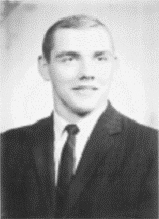 |
 |
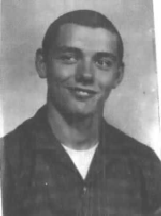 Ned
Richard Heintz was born on June 15, 1946 in Shelby County, Ohio. His parents were Vernon L. Heintz, who died in January 1992, and Ethel
Heintz, who died in August 1995. Ned
Richard Heintz was born on June 15, 1946 in Shelby County, Ohio. His parents were Vernon L. Heintz, who died in January 1992, and Ethel
Heintz, who died in August 1995.
Ned,
age 13 in the 8th grade
Ned
graduated from Riverside High School in Logan County, Ohio in 1964 and from Ohio
State University in June 1968. He
was the student council president in high school, and played on the schools
varsity football and basketball teams. Being
from an agricultural family he was especially proud of the special honor he
received as being named the F.F.A. State Farmer of Ohio in 1964.
On
May 11, 1970 The 281st AHC established a forward operations base at
Camp Holloway, Pleiku, RVN in preparation for aerial operations into Cambodia.
At approximately 8:55 p.m. on May 11, 1970 the base at Camp Holloway came under
enemy rocket attack and Ned was seriously wounded when a rocket exploded in the
immediate area of his living quarters. The
same rocket also killed four crewmembers of the Wolf Pack gun platoon that were
in an adjoining tent. They
were Sgt. Joseph W. Cunningham, Sgt. Scott E. Sutherland, Sgt. Daniel J. Vaughan
and Specialist 4 Danny J. Taulbee. Also seriously wounded was 1st Lieutenant Jared H.
Bahre of the 1st Platoon (Rat Pack). Ned was immediately taken to the 71st Evacuation
Hospital in Pleiku, RVN. There,
despite the efforts of doctors and skilled medical personnel, Ned succumbed to
his wounds at 3:20 p.m. on May 16, 1970. In
December 1970 at ceremonies on the Bowling Green State University campus, Ned's
widow, Mrs. Karen Heintz was presented posthumous awards by the University's
ROTC department. Mrs. Heintz was
presented with the Bronze Star Medal, Air Medal with Second through Tenth Award
and the Purple Heart. She also
received decorations, which were awarded to her husband prior to his death,
including the National Defense Service Medal, Vietnam Service Medal, and Vietnam
Campaign Medal. Ned’s
brother Larry Heintz of 11620 West Elmore East Rd, Oak Harbor, Ohio and nephews
Matthew and David Heintz, and a niece Camille Heintz survive him. Biography
Prepared by: |
|
Ned's Remembrance He
loved to play any kind of ball on Sunday afternoon with buddies.
He was always on winning teams. Baseball
in Pony League, his team won several championships.
Basketball his Jr. and Sr. years in high school. His team was League
champs and went to the Regionals. Football
his Senior year, the coach switched him from tight end after the first few games
when they couldn't score to fullback and put the fullback at halfback, and they
finished the season unbeaten and 1 and 2 in scoring and won the conference
title. He was truly a team player,
not caring what position he played, so long as he could contribute to the team. He just seemed to be a natural born leader who was a people person who loved to voice his opinion. In high school, he was Student Council President both his Jr. and Sr. years and was President of the Future Farmers of America for 3 years and became a State Farmer. His Senior year, he led his Student Council in a debate in front of the student body on school finance before a much-needed school levy was to be voted on. Needless to say, the levy passed very easily. After our trip to D.C. for the 281st Reunion and Memorial Service last July, Karen and I visited Ned's hometown, DeGraff, Ohio and met with his Senior Class Secretary who stated that their classmates have maintained a $500 per year scholarship in his honor for the past 30 years. Just
before he left for Viet Nam, he and his wife, Karen, bought a farm about 2 miles
from Mom and Dad, and he was planning on farming and maybe doing some crop
dusting or spraying when he returned. He
spent his last 6 weeks before he left working on his farm and making plans.
HE ALWAYS HAD A POSITIVE ATTITUDE. Being
nearly 5 years older than Ned, our interests were at a different level.
I regret that we could not share our adult lives together.
Even with the age difference, we did have a fierce competition in
anything we participated in. HE WAS ONE TOUGH LITTLE BROTHER. Larry Heintz, Brother A
Letter From Mrs. Ned Heintz A
heartfelt thank you to all the 28lst for including us in the Remembrance
Ceremony held in Washington, D.C. last July.
We were a little shocked to hear from Roger Green after so many years and
were so glad to be invited to attend the ceremony.
It was a very emotional time for everyone present and, yet, very
reassuring to see that you guys still have a bond that even years cannot break
and that you have always remembered the ones you left behind. Ned
and I met in September, l967, when he was a student teacher in the Agriculture
Department at a high school in Ohio, and I was a first-year Business teacher.
I can still picture this tall, handsome man walking into my classroom
after school early in September and confidently introducing himself and asking
me to show him around town. We
seemed to immediately mesh together and continued to date when he returned to
Ohio State University in January to complete his senior year.
We became engaged in April, l968 and shared pinning on his 2Lt. bars at
his ROTC commissioning and graduation in June, l968. Ned
started flying fixed wing aircraft while still a student at OSU and was hooked
from day one. We married in
September, l968 and began "our" Army life in November, l968. Ned always called me his "co-pilot" (as if I flew
the plane). Our first posting at
Fort Knox, Kentucky from November, l968 to March, l969 for Armor Officer's Basic
School was a new experience for both of us.
We spent hour’s spit shining his boots, polishing his brass, learning
how to "read" military rank and how military protocol works.
The 4 months was a new adventure during the winter for newlyweds freezing
in a WWII-vintage trailer off-post. Love
conquers all.
Ned
and I planned to move back to Ohio eventually and settle on the farm we bought
while he was on leave before departing for Viet Nam.
As much as he loved flying, he loved farming more.
Before we left for the airport in Dayton, Ohio in December, l969 for his
departure for Viet Nam, we made one last stop at our farm to walk around the
snow-covered fields. This is where we were going to settle down, raise children,
and forge out our future. It was
very difficult to see our farm this summer and see someone else living our
dream. Ned always had a plan and
was determined to meet every goal with a stubborn will that never let up until
"the job was done." His
enthusiasm, optimism, and love of life and people always were there and rubbed
off on everyone around him. I
feel very blessed to have shared those precious years with such a wonderful man.
He will always be in my thoughts as he was a very special person who is
missed by so many people Good memories do last forever. God
bless all of you and keep the flame going.
We all need each other so that we will never forget the things we all
shared. All of you are truly
"such good men". Ned
would be proud!! Karen Heintz Forcht
Roger
C. Green, Jr. When Ned Heintz arrived at the
281st in early 1970 he was assigned as assistant platoon leader in
the "Bandit Platoon". I
was the platoon leader at that time. Like most young officers fresh out of
flight school he wanted very much to fly, and make Aircraft Commander.
The only duty I gave the assistant platoon leader in the Bandits was to
learn to fly and to survive. Having
what I felt were the best pilots in the 281st, I knew it would not
take him more than a few months to gain the experience and expertise to be an
AC. Ned was a very enthusiastic
outgoing person and it didn't take him long to fit in with the platoon pilots
and crew chiefs. At that time we
had four or five new Lieutenants and they did tend to hang together and did some
serious partying. The 281st BOQ had
the officers living on the first floor and the Warrants lived on the second.
The rooms were small but had enough space for two occupants to live
comfortably. On the first floor CPT
Jim Brown took the wall down between two rooms and made a party room with a
small plywood bar and big refrigerator (borrowed from the 5th Group).
This became a gathering place for any of the pilots night or day, when
not on a mission. After Jim left,
Steve Bovio and I inherited the room and expanded it to three connecting rooms.
Eventually Ned and Jerry Bahre moved into the room and it continued to be
a party area. Some local musicians
such as John Korsbeck and Bob Edgley often gave impromptu concerts there.
Late one night during one of our get togethers, someone remembered that
the 5th Group field grade quarters had a nice lounge area with a
bamboo bar. It was decided by a
unanimous vote by all present the bar could be better utilized in our room. At that time I believe it was Ned and about eight other
pilots that quietly sneaked into the field grade BOQ, also where our commander
MAJ Stevens lived and borrowed the bar for out room. I kept waiting for MAJ
Stevens to say something about the missing bar.
It was never missed. I will never forget how glad I
was to see Bob Mitchell, Ned and their crew chief Ron Lee when they picked us
from a very hot LZ one morning. They
performed in the true 281st tradition, bravely and as a team. The last time I saw Ned was on
11 May 1970. Ned, Jerry Bahre and
myself had packed our bags and were getting on the helicopter headed to Pleiku
to participate with the unit in the Cambodia invasion (Operation Binh Tay I).
The unit was already setup in Pleiku and MAJ Stevens, the CO was flying
additional pilots up for the operation. At
that time I was the Company Executive Officer and the Commander decided that I
should stay in Nha Trang and run the rear operation.
I reluctantly got off the helicopter.
That day we lost five outstanding soldiers to a rocket attack on our base
camp at Pleiku. Ned clearly had his future
laid out after the Army. He and his
wife Karen were both schoolteachers and had a farm in central Ohio where they
were going to make their life together. He
thoroughly enjoyed flying but farming was his real passion.
Ned was a friend and an
outstanding officer who I will always remember.
Not a day goes by that I don't remember those soldiers I served with in
the 281st. They were my
friends and comrades who I trusted and was willing to die for if necessary. Roger C. Green Jr.
To:
28lst AHC members and their families: I'm submitting this letter to
our Book of Remembrances for Ned Heintz, but also for all our guys who died in
Viet Nam. Ned, Jim Kelly, and I were
assistant platoon leaders in early l970. That's
a status that marked us clearly as not in command of the platoon, and not
in command of the ships in the air (the clear venue of the warrant
officers). We were acutely aware
that we were expected to achieve both platoon leader and AC status within a
period of months. Consequently, we, along with one or two other stray
lieutenants, were the most comfortable and formed the strongest bonds with each
other. Ned was the most athletic
member of the company that I can remember.
When we all had an uneventful night in Nha Trang, we'd have a midnight
basketball game, either against each other or some SF headquarters people.
Most of us took up space under the basket, while Ned scored points off
his hook shot. Another thing I remember is
the day Steve Bovio died. Many
of you who were my close friends were there.
I wasn't. Ned was. I left Viet Nam abruptly in
May, l9070, wounded by a rocket that killed five of our guys. While in the hospital at Qui Nhon, I had been informed of the
other casualties. When I returned
to the States and was discharged, I knew that I had lost a lot of friends, and I
had the impression that there were probably more, and I didn't need to know
that. That is not to say that I
didn't think about our company. Here,
I can count maybe twenty people who would drive five miles in a snowstorm to get
me if my car broke down. There, it
goes without saying, each of us risked or sometimes lost his life to save
another. So, I didn't have any contact
for thirty years with the 28lst, until June, when Roger Green called me and told
me about the Memorial Service in D.C. My
wife and I attended. It was a
wonderful thing. First and
foremost, to honor and remember our fallen.
And second, to re-establish ties with our company. Ned Heintz was my friend.
So were several of the others remembered here.
The ones I knew and the ones I did not know personally, I am proud to be
in the same company with them. Sincerely, NED HEINTZ
I
was asked to write my memories of Ned Heintz some 30 years after my acquaintance
with that fine young man. What follows is my best recollection of the events
leading up to and including the evening of May 11, 1970 particularly in regards
to Ned. All matters mentioned herein are subject to correction by “facts”
which aren’t necessarily part of my memories. (In other words, I also am
subject to the CRS disease). The purpose of the story, although perhaps a bit
long-winded, is to describe the conditions under which Ned lived the last days
of his life and the rocket attack, which claimed it. I
arrived at the 281st a day or two after New Years, 1970 and was
assigned to Rat Pack. During my newbie period, I ran into a number of people I
had known in flight school, including Jerry Bahre who introduced me to a long
tall LT named Heintz. We were all in about the same condition, all FNG’s, all
trying to get our check rides, get in the air and learn what was expected of us.
All the while trying to figure out how to stay alive. The unit had just lost a
full crew a little over a month before we got there and was still the subject of
considerable talk in the barracks, BOQ and WOPA Alley. Additionally, the unit
had a workload that was staggering in terms of hours flown. It took me two weeks
to get an in-country check ride because they couldn’t free up one of our
IP’s from mission assignments. In
February or March, Roger Green was kicked upstairs to become the XO and I took
over as Platoon Leader of the Bandits. I don’t remember the TOE for the
platoon but remember there was 1 or 2 other Captains, 4 or 5 LT’s, 20-30
Warrants and probably as many NCO’s and EM for the 11 helicopters and assorted
ground vehicles, tentage and such. Ned, like all the other LT’s, was primarily
a main line flyer, utilized pretty much like the warrant officers. Again, we
were all flying 100 hour plus months, which didn’t leave much time for
anything else. Important things like vector control officer, unit fund advisory
committee, and the like. Ned, like all other LT’s, was flying his butt off. If
my memory serves me, 90 hours was all you could fly a month without a medical
waiver. Those waivers became routine and at 140 hours we were supposedly
grounded. I remember plenty of nights, sitting in Operations analyzing all
mission assignments, trying to estimate the number of hours it should take for
each mission and then, assigning a crew that could fly that number of hours
without exceeding the 140. It wouldn’t have surprised me if Ned had flown 600
hours in the 6 months he was there. Also, during that time, the
unit was experiencing a large number of casualties. It seemed like every other
week we were losing people in combat and non-combat operations. We lost eight
people during the month of February alone. I believe Ned was part of the flight
that heard Steve Bovio as he was hit. I was flying PP toward the rear of the
flight when Steve was hit by a bullet that had somehow came through the wing
window (really wasn’t a wing window in that it did not open but was positioned
like a wing window in an old model car) missed the armor plating and then missed
his “chicken plate”. It doesn’t look possible but it happened. The bullet
went through his spine causing immediate paralysis and as his foot was on the
floor mike, we heard his groaning for several long minutes before the flight
leader finally came up on an alternate channel and had us change frequency.
Steve died a couple of days later. Ned, like the rest of us, was scared but got
up the next morning, strapped in and flew another long day. I
don’t remember the exact date but sometime during February/March, I woke up to
a hellacious noise in the hallway of the BOQ. I walked out of my door to find
out “what the hell was going on” (indicates my mood) and was promptly doused
with a bucket of water. I punched the person holding the bucket-Lt Ned Heintz.
(For thirty years that I’ve been telling this story, I could have sworn that
he was celebrating the birth of his child- but Karen tells me it must have been
a nephew or something because she had no children by him) After finding out the
cause for celebration, I apologized to him and joined into their merriment.
Sometime
in early May, I was awakened by an operations clerk and informed that the
missions I had just assigned a couple hours before had been cancelled and that
we were told to standby for a new mission. Finally about 3:00 am, we were told
to take about half the company to Camp Holloway (Pleiku) and get a mission
briefing from the 52nd (?) Aviation Battalion there at 6:00 am. We scrambled our
crews and equipment and arrived on time, even though it was a 2-˝ hour flight.
The mission-support of ground operations in Cambodia. Even
though we got there on time, many other units had arrived before us. As such,
all habitable structures were taken. We had revetments for the aircraft but had
to pitch GP medium tents to sleep in. We placed them in two rows, three tents in
each row on a baseball field complete with backstop. We had an aircraft lighting
set (a set of lights with generator that
was generally used to work on aircraft at night) placed to shine light down the
center aisle. Also, due to our lateness in getting into the Cambodian operation,
there were no sandbags or 55 gallon drums (which could be filled with water)
left to provide protection. The plan was to get to the ditch surrounding the
baseball field during mortar or rocket attacks. In thirty years of retrospect,
I believe that we had a serious disrespect for rockets and mortars. In Nha
Trang, we would get on top of our bunkers, drink beer and watch the VC mortar
Camp McDermott (?) (Army installation at Nha Trang over next to the mountains).
Our facilities were out of range for the VC and as such we didn’t have any
first hand experience with that. Also, I believe most of us had developed an
attitude that we would only die by that “bullet with our name on it” and
when it was our time, nothing you could do would prevent it.
As I got older, I realized that there were a large number of bullets
addressed “to whom it may concern” but they don’t send old guys to war, do
they? We were up there several days and flying our asses off. May 11th was a particularly hard day for me. I had been in the air like 8 of the 14 hours out as a Charlie-Charlie (Command and Control) with a full Colonel from the 4th Infantry Division who couldn’t read a map. He wanted to put his people into the valleys (he thought they were ridgelines) and my PP was an FNG who couldn’t be relied on to fly a given course or heading. Upon my return (about sunset), I headed for the tents to drop off my gear before I attempted to find a good meal and cold beer. I don’t remember now just which tent I slept in but was right between the backstop of the baseball field and the first tent in that row when the first rocket came in. My map bag went one direction, my helmet the other and I went to the ground. The rocket landed down in the revetments. I jumped up and ran over to the ditch surrounding the field about 10 meters from the doorway of the second tent in that row. I remember a warrant officer (Schulz?) was there before me. He was a second tour guy having spent the first year as a grunt. He said “you had better get those guys out of there” and I said, “Why, aren’t they coming?” He said, “No, they are putting on their boots and getting dressed.” At that point, I started hollering for them to get a move on it. I don’t think there was as much urgency in my voice as there should have been, because I, like they, believed it would be a one round attack and that we would probably lay in the ditch for a while before getting up and going about our business. If I remember right, we had had a couple of those type attacks in previous nights. At any rate, I was in the middle of one of those “coaxing’s” when I heard the whistle of the next round. I barely had time to drop my head before one hell of a blast tore through area. After the dirt and debris had stopped falling, I lifted my head and looked toward the tents. The second tent had sustained the most damage. The shrapnel had cut the corner post, allowing the top to drape down. The lighting set shining down the center aisle silhouetted all of the holes in the second tent. I jumped up and ran toward the tent and stumbled into the crater the rocket had left. It was about 10 ft long, 2 ft wide and 2 ft deep. I regained my footing and made my way into the tent. Immediately to my left was Cunningham, still in his sleeping bag with a large piece of shrapnel lodged in his chest. Cunningham was a previous member of the Bandits, having transferred to the Wolfpack only a couple of week’s prior. His eyes were open and obviously dead. Immediately to my right were a couple of guys I didn’t recognize that had chest wounds. I forgot the name but there was a warrant officer there who had taken charge. He sounded like a medical doctor with his specific directions on what to get and how to dress the wounds. About that time, someone was shouting that we had no way to get ambulances or corpsmen. I knew there was a phone down in the end tent on the other row of tents so made my way through the rubble, noticing several other people down and some walking wounded. (One Staff Sergeant from the gun platoon was walking but had some very colorful words to say about his situation) I got to the location of the field telephone and found a sharp young operations clerk (Jewish kid from New York) who had the TOC on the line but he didn’t have a whole lot of information to give so I got on the phone and told him we had 8 or 10 down, send all ambulances and if they sent too many we would send them back the ones we didn’t need. I headed back
for the second tent. There, lying well out of the tent was Jerry Bahre. I
didn’t even know Jerry was up there, apparently arriving that day. Jerry and I
had been in flight school together and had even had him over for supper. (He was
a bachelor). Jerry was propped up on his elbow, holding his crotch and in his
quiet, gentle manner saying something about this had better be a wound that
would send him home or he was really going to be pissed. I looked at his wound
and assured him that he would be back in the unit within two weeks. (Fortunately
for him, I was not his doctor because he got a medical retirement and went on to
marry his college sweetheart, become a lawyer and then own a construction
company.) I
left Jerry and went to the second tent. Lying in the doorway of the tent was a
large fellow covered in dirt and blood. Another guy and I pulled him on clear of
the door and rolled him over on his back. He was still conscious from the look
in his eye but could not speak. I told him to not try and that he would be out
of there in a few minutes. He had taken shrapnel in the leg and lower stomach.
He was bleeding badly, particularly from the leg wound. I tried a compress
bandage but it didn’t hold so used my belt for a tourniquet, which seemed to
work. About that time the ambulances arrived. One of the medics had apparently
been shaving because he still had soap on his face. I hollered at him to get
this one out first and there were two more on the other side of the tent that
needed to go next and the rest were either dead or less severe. The medic laid
down the stretcher next to him and grabbed his feet. I lifted his shoulders and
we put him on the stretcher. Another medic got there then and together they
carried him to the ambulance. I then went back in the tent to direct traffic,
clear aisle ways, etc. It was only later when trying to put together a list of
casualties that I found out Ned Heintz was the big guy in the doorway.
For
several days thereafter, as our flying would permit, a group of us would get in
an old ľ ton and drive over to see him. He wasn’t conscious but we would talk
to him anyways. The doctors explained to us (as I remembered it) that they just
couldn’t stop the bleeding. He had so many wounds that he had virtually lost
all of his original blood and the coagulants from some one else’s blood
wouldn’t work with him. Anyway, I believe they did everything they could do
for him and that he was in no pain. Ned Heintz was a good soldier.
He did everything that was expected of him and then some. During some very
trying times, he persevered. He loved flying and the people around him. He was
as solid as a rock. Marshall
Hawkins Bandit 26
|
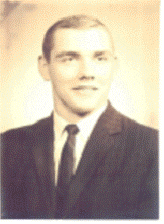
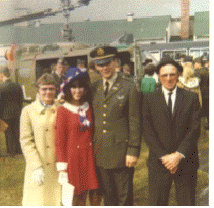
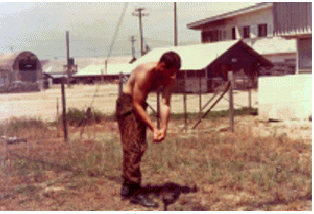
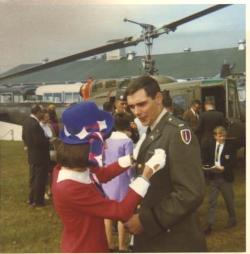 Our
next assignment was to start flight school at Fort Wolters, Texas (March, l969
to July, l969) and celebrate the check rides and the first solo that was
accompanied by opening a bottle of champagne that had been chilling in the
refrigerator for the occasion.
Our
next assignment was to start flight school at Fort Wolters, Texas (March, l969
to July, l969) and celebrate the check rides and the first solo that was
accompanied by opening a bottle of champagne that had been chilling in the
refrigerator for the occasion.